From the Romans to equal marriage: A history of Britain’s 2000-year march towards sexual liberation
The first Pride parade in London 50 years ago was preceded by hundreds of years of struggle, with sexual liberation at its core. David McGillivray looks back at its multifarious history and some of the brave pioneers who risked their lives for wanting to be themselves
By Will Stroude

Words: David McGillivray
For the greater part of the past 2,000 years the men who governed the British Isles were obsessed with something of almost no importance. Sodomy. This is despite the fact that there was disagreement about every aspect of the activity — including precisely what sodomy is. Nevertheless, the consensus for hundreds of years was that bum sex was such an abomination that practically everybody caught in the act had to be killed. Not only did that decision not solve the problem, it appeared sometimes to cause even more confusion.
Throughout this moral panic, brave men continued to have sex with each other, while even the ordinary folk who didn’t fancy it seemed excited by the thought. They packed the courtrooms when gay gentlemen came to trial. After far too long, sanity prevailed. First, the death penalty for buggery was repealed in 1861. A mere one hundred years later, in 1967, homosexuality was partially decriminalised. But as activist Peter Tatchell observes, “Until 1999, Britain had the largest number of anti-gay laws of any country in the world, some of them dating back centuries.”
No wonder we have annual Pride parades. We need constantly to remind ourselves that what we’ve gained could be snatched away.
The problem with gay sex seemed to coincide with the start of Christianity. Christians went along with Jewish-Roman theologian Flavius Josephus (37/38–100 AD), the first to claim that Sodom was destroyed because of sexual perversion. “Sodomite” took on a whole new meaning. A convoluted law from 342 AD appears in both the Theodosian Code and the Code of Justinian from emperors Constantius II and Constans. It decreed that marriage based on unnatural sex should be punished. In 390 AD, Emperor Valentinian declared homosexuality illegal — although just 20 years later the Romans left Britain.
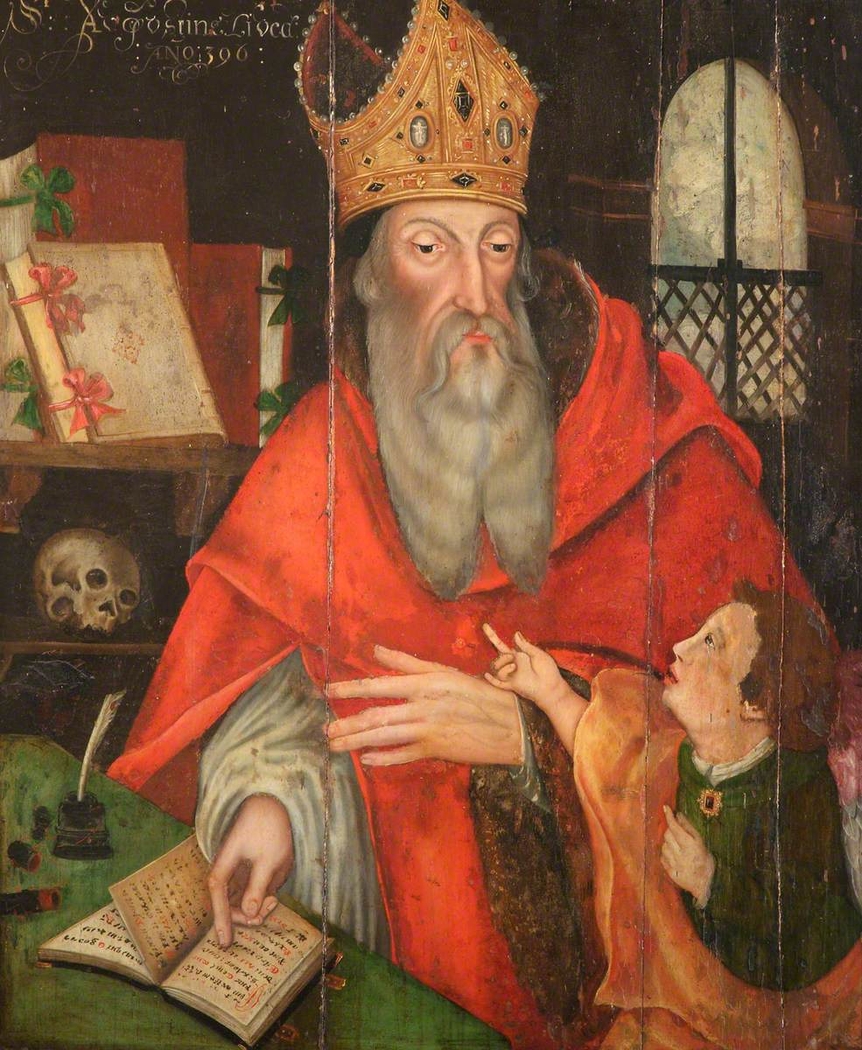
No Saint: St Augustine of Hippo
Around this time, Augustine of Hippo (354–430 AD) converted to Christianity, became a priest and a bishop, and devoted himself to philosophical and theological works. The New Yorker writes that: “He went on to shape Christian theology for both Roman Catholics and Protestants… There has probably been no more important Western thinker in the past 1,500 years.” Shame then that he was repulsed not only by gay sex but sex of any kind — despite having previously had relationships with both men and women — and blamed all the woes of the world on women.
BURN IN HELL
In 597, Pope Gregory despatched missionaries to Britain to bring the word of God to the mostly Pagan Anglo-Saxons. Faced with the prospect of burning in Hell for eternity, Britons duly became Christian.
In 1102, the Roman Catholic Council of London was convened by Archbishop Anselm of Canterbury to clean up the clergy. It condemned those who “commit the shameful sin of sodomy”. But Anselm refused to publish the decree. Based on Anselm’s passionate letters to monks and male relatives as evidence, gay historian Rictor Norton reckons that Anselm was gay. “Anselm’s letters”, he writes, “appeared during the last flowering of homosexual love, before fanatical anti-gay prejudice swept across Europe in the 12th century.”
Before we move on to examine some rare recorded examples of men having sex with men in medieval times, let’s consider that phrase “homosexual love”, which suggests the continuous existence of the kind of society we know today. Nothing could be further from the truth. The concept of homosexuality would not be expounded for more than 800 years. In fact, we know less about the nature of gay sex in Britain prior to the Reformation in the 16th century than we know about Ancient Greece.
For most of the history of the British Isles, there are no written records. After we learned to write, sodomy was so “revolting” and “unnatural” that the exact meanings of records of gay sex often have to be guessed at. We’re not even sure what is implied by records of men sleeping together.
Men slept together from Celtic times to the 20th century. Many did so for cultural or economic reasons. They weren’t necessarily bonking. Richard the Lionheart is generally regarded to have been one of our many gay monarchs. More than one recent source refers to his majesty’s love affair with Philip II, the King of France. But this information derives solely from chronicler Roger of Howden, who in 1187 wrote that “at night the bed did not separate them”. But were they, in today’s parlance, lovers? Who knows.
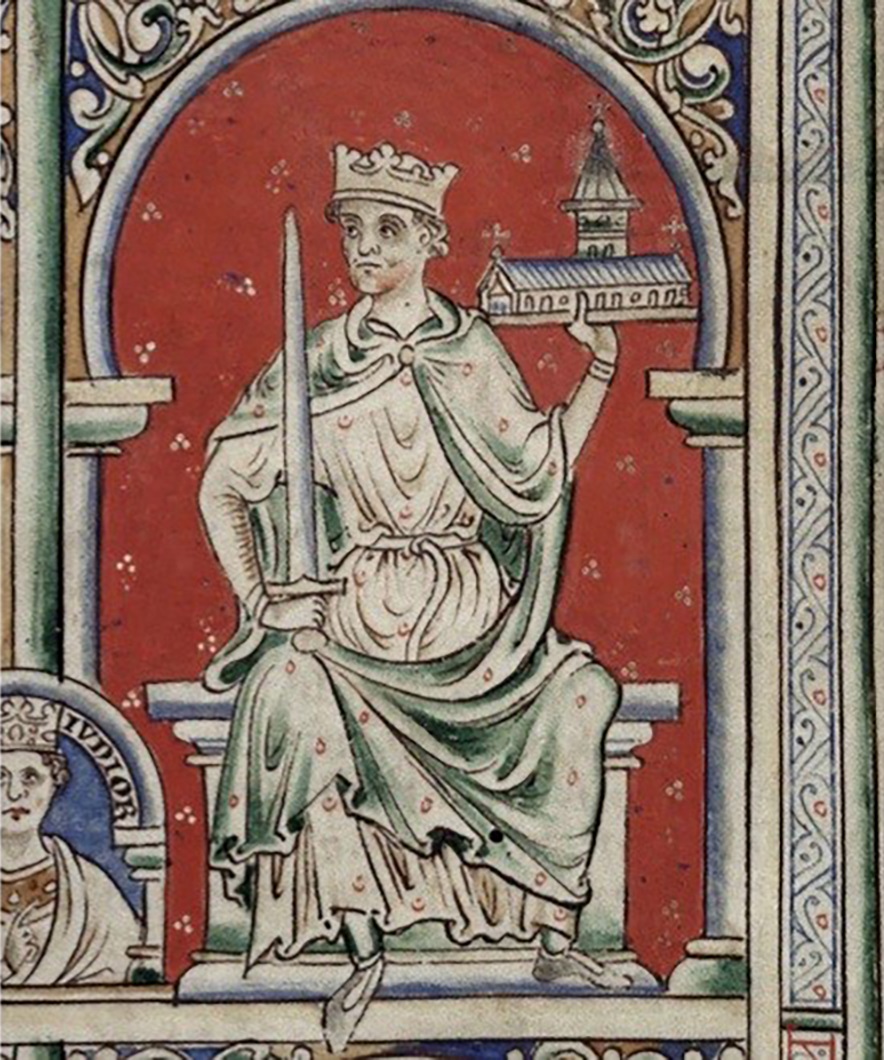
Pink Power: Was Richard the Lionheart England’s first gay monarch?
The first recorded example of gay sex of which we can be reasonably sure dates from 1394 in a case recorded when it was heard before the Mayor and aldermen at London’s Guildhall. John Rykener (dressed as a woman and going by the name of Eleanor) and John Britby were arrested for “committing that detestable, unmentionable and ignominious vice” in the street near Cheapside. Both admitted that a fee had been agreed.
CHURCH OVER STATE
The vice may have been sodomy, but this supposition is based on insubstantial factors: Britby wasn’t charged and there’s no record of a charge against Rykener. This may have been because the pair were arrested before the sausage had been sunk, or because sodomy was dealt with by church rather than state courts. Or was it more that the courts just didn’t know what to make of such a case? Was there even a law in place for dealing with a male prostitute presenting as female? It’s unlikely.
Whatever the situation, we learn that, even from the earliest times, sodomy was something that, no matter what the law decreed, the church courts preferred not to pursue. Throughout the 15th century, church court records have only a single reference to sodomy. In 1471, William Smyth, a parson at St Giles’s church in Winchelsea, Sussex, preached that he had committed “a sodomitic crime” with one Thomas Tunley. Even this case was dropped, simply because Tunley didn’t appear in court.
There’s more than meets the eye to the Buggery Act of 1533. Britain’s first civil sodomy law, passed during the reign of King Henry VIII, moved the issue from the ecclesiastical courts to the state and made the beastly business a capital offence. The act did not explicitly target sex between men — it also applied to sodomy between men and women and a person with an animal. However, convictions of men for sodomy were by far the most common and well publicised. The new law was aimed primarily at monks, infamous for buggering boys and each other (as well as having sex with women). But the measure was more specifically the first of many taken by Henry VIII in his monumental hissy fit with Rome. It was followed in 1534 by the Act of Supremacy, which made Henry supreme head of the church in England, and then his dissolution of the monasteries.
In 1553, Catholic Queen Mary cancelled the 1533 law, bringing the issue back to the ecclesiastical courts — only for Queen Elizabeth to reinstate it in 1563.
AN UNNATURAL CRIME
The number of men executed for sodomy before 1861 — when the Buggery Act was included in The Offences against the Person Act and made no longer a capital offence — is difficult to estimate. Often the charge sheet lists only “an unnatural crime” that may have been bestiality or what would now be called child abuse. Sometimes men were executed for multiple crimes that may have included sodomy. The law was difficult to interpret, and judges sometimes threw out cases if the defendants had not been adequately observed or occasionally if semen had not been ejaculated. The rules of evidence ensured that relatively few men were found guilty of sodomy: for most of the period from the 17th century until 1861, to prove this crime there needed to be at least two eyewitnesses and evidence of both penetration and ejaculation.
What is more demonstrable is that the death penalty didn’t deter men from having sex with each other. One of these men was the highest in the land, King James I, who came to the English throne in 1603, only 70 years after the passing of the Buggery Act. He was married and had eight children, but he also had a string of young men on the side. One of them was pretty George Villiers, the first Duke of Buckingham, who is fittingly commemorated by London’s Villiers Street, whose most famous occupant has long been the gay nightclub Heaven.
This is not to say that aristocracy automatically bestowed immunity from prosecution. There is the notable case of the Earl of Castlehaven, beheaded in 1631, although again not solely for sodomy (of his page, also executed). His Lordship was also convicted for assisting in the rape of his wife. In A Gay History of Britain, Randolph Trumbach surmises that “In his relations with his male servants, Castlehaven was probably typical of many men.”
The “true” attitude to gay sex in the 17th century can be found all over the place. Trumbach has also discovered that “A third of the 300 plays for which texts exist for the period from 1601 to 1642 [when London theatres were closed by Parliament] have some reference to sexual relations between men and boys.” In 1649, politician Clement Walker wrote of “sprintries”, possibly male brothels, in the area of a mulberry garden created by James I. (The building now on the site is Buckingham Palace!) In his diary entry for 1 July 1663, Samuel Pepys writes that he has heard that “buggery is now almost grown as common among our gallants as in Italy.”
Molly houses — meeting places for gay men often in pubs and coffee houses — were also male brothels, but more than that they were part of a cultural revolution, the first large-scale rebellion against unjust laws. Somehow they managed to survive for the whole of the 18th century despite escalating raids and prosecutions, many instigated by vice squads such as the Society for the Reformation of Manners.
PROTECTION RACKET
The molly house was usually run by a woman, with upstairs rooms in which men dressed and behaved as women, enacted marriage and birth scenarios, and had sex with each other and/or their admirers. The cult must have been an open secret because an obvious molly, Mr Maiden, appears in Thomas Baker’s 1703 play Tunbridge-Walks or The Yeoman of Kent. “Baker was probably a molly himself,” states Randolph Trumbach. Whether or not this is true, Baker certainly understood the molly character, as did the audience. The play was Baker’s biggest success.
In 1726, The Weekly Journal reported that “20 houses have been discover’d, which entertain’d Sodomitical Clubs”. The following year the prosecution of bent copper Charles Hitchin explains to some extent how these clubs kept going. High-ranking Hitchin had been taking protection money from the molly houses he was supposed to be closing down. Not only that, he was gay and had been joining in the fun. And he wasn’t the only one. Clearly the system wasn’t working.
According to Voices and Visibility, “Prosecution for buggery was rare until the 1700s. In England most executions for buggery happened after 1800. From 1806 to 1861 there were 8,921 prosecutions for buggery [in England and Wales]. The courts gave 404 death sentences. 56 men were executed. James Pratt and John Smith were the last two Englishmen hanged for buggery in 1835.”
Those who were given the death sentence but escaped execution were either imprisoned or transported to Australia for life.
In 1828, the Buggery Act was repealed, only to be replaced by an Offences Against the Person Act which exclusively penalised same-sex activity between men, with the death penalty unchanged. The 1861 Offences Against the Person Act saw sodomy — and multiple other crimes — made no longer a capital offence. Instead the penalty was replaced with life imprisonment or a minimum term of at least 10 years.
But the stage was set for the great gay sex upheaval of the second half of the 19th century. It began in 1870 when female impersonators Frederick Park and Ernest Boulton, known professionally as Fanny and Stella, were charged with conspiracy to commit sodomy (with their sugar daddy Lord Arthur Pelham-Clinton, who committed suicide before the case came to court). The charge was impossible to prove and the men were released.
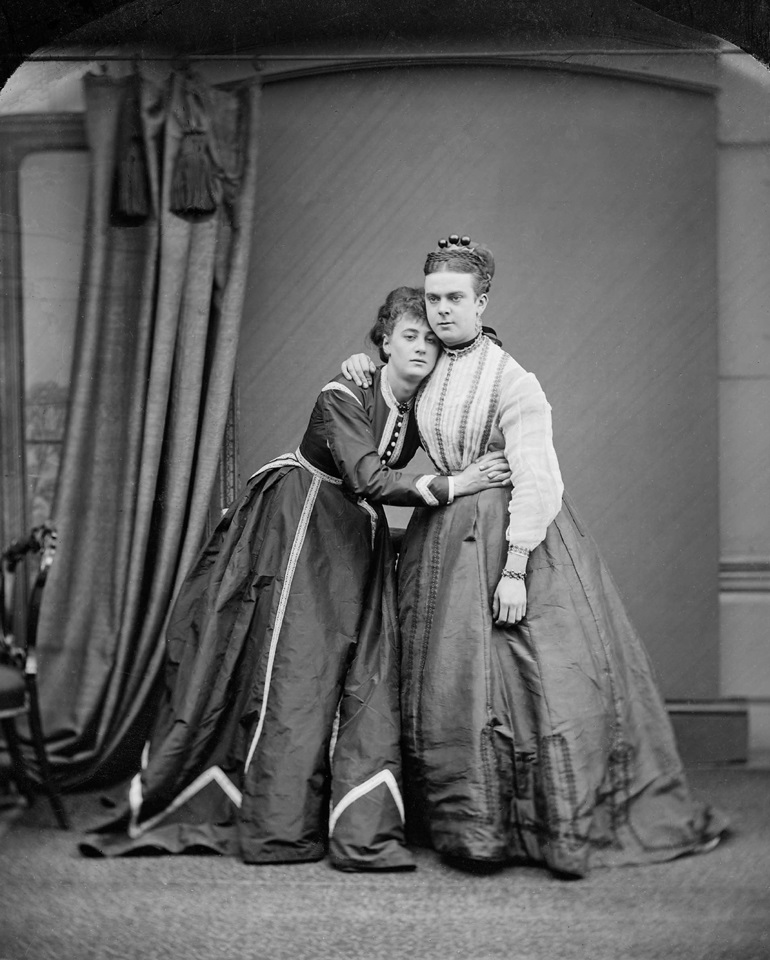
Skirting the issue: Fanny and Stella
In 1880, Manchester police were convinced that something disgusting was going on at the Temperance Hall, Hulme. They had to climb on to a roof to peer through a window and all they could see was 47 men dancing the can-can. Nevertheless everyone was charged with the same offence as Park and Boulton. They were bound over to keep the peace for 12 months — paying two sureties of £25 each, then a considerable amount — as a guarantee. Some ended up in prison for three months because they couldn’t afford it. A succession of failed prosecutions such as these convinced the government that the law had to change.
GERMANY RULES
The Criminal Law Amendment Act 1885 criminalised all sexual activity between men. Henceforth one man winking at another in the street could be enough to prove importuning. In 1895 Oscar Wilde was indicted on 25 counts. Sodomy was not one of them. Wilde famously tried to justify “the love that dare not speak its name” by referencing David and Jonathan, Plato, Michelangelo and Shakespeare. It didn’t wash. Ireland’s greatest playwright was sentenced to two years’ hard labour. Sixty-seven years later, Alan Turing, who helped win the Second World War for the Allies, was convicted under the same law.
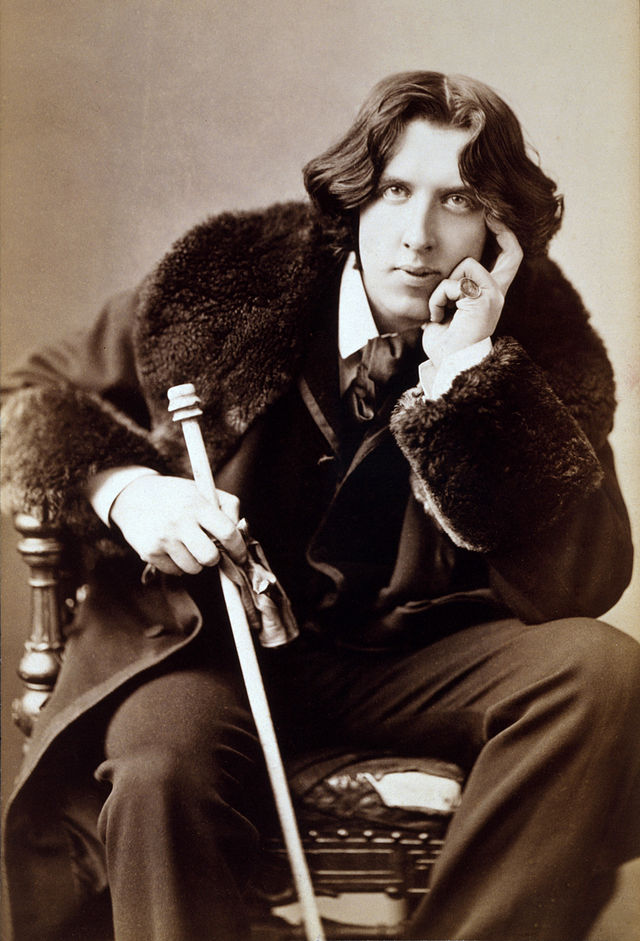
Prisoner of love: Oscar Wilde served two years
After the downfall of Oscar Wilde, British gay life returned underground. For more than 40 years, all the great breakthroughs in homosexual rights, law reform and artistic representation came from Germany. (It was a German, Karl-Maria Kertbeny, who first coined the word “homosexual” in 1869.) In Britain, there was a quite different development. “Part of the response to the scandalous events of the 1880s,” writes H.G. Cocks in Nameless Offences, “was a growing interest in sexual behaviour and its social significance.”
The main instigator of this homophile renaissance was the American gay poet Walt Whitman, whose incomprehensible yet highly influential work Leaves of Grass was first published in 1855. A fan of his was writer and philosopher Edward Carpenter, who lived with his long-term male lover in Millthorpe, Derbyshire. Gay rights were just part of this visionary’s agenda, which also included women’s liberation, vegetarianism and ending air pollution. Decades after his death, Carpenter’s writing helped inspire Gay Lib. He’s destined to be recognised as the single greatest influence on 21st-century gay life.
For around 1,500 years, the men who made the laws had barely given the threat of gay women a second thought. But after the First World War they were causing big trouble by demanding emancipation. In 1921, Parliament discussed an amendment to a Criminal Law Bill that would make lesbianism illegal for the first time in history. In the end, both Houses rejected the amendment, but their logic was distinctly Victorian: they worried that a ban on lesbianism might encourage women to try it.
Meanwhile men suffered the same old discrimination. Between the wars, drag balls and parties were popular. But they were as illegal as they had been in the 19th century.
In 1932, two plain clothes police officers, PC Chopping and PC Labbett, infiltrated a party in Holland Park, West London. According to the National Archives, they participated enthusiastically in proceedings rather than maintaining a professional distance. They “share dances, they have conversations about possible sexual contact, and they let themselves be kissed and touched intimately. They engage in role play more elaborately than they might.” Their colleagues arrived and arrested around 60 men. In court, George Morgan protested, “Surely in a free country we can do what we like?” No chance. Twenty-seven men were found guilty of ‘diverse lewd, scandalous, bawdy and obscene performances and practices’ — in other words, having sexual relations with other men.
PUBLIC FIGURES
There was far more persecution of gay men and trans people after the Second World War. Britain scoffed at America’s anti-Communist crusade, but because of our unquestioning homophobia, we believed the Yanks when they told us that homosexuals endangered national security. After consulting the FBI, Metropolitan Police commissioner John Nott-Bower swung into action. According to Hansard, in 1938, the number of unnatural offences known to the police in England and Wales was 134; in 1952 it was 670. Similarly, the number of attempts to commit unnatural offences (including indecent assaults on men and “importuning for immoral purposes”) in 1938 was 822; in 1952 it was 3,087. Finally, the number of offences of gross indecency in 1938 was 320; in 1952 it was 1,686. In 1955, this figure rose to 2,504.
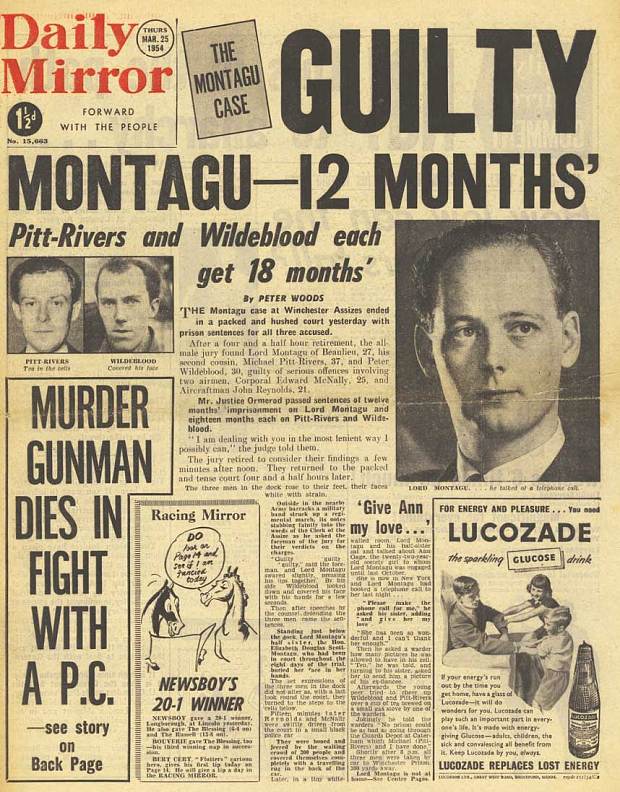
Headline news: The ‘scandalous’ case of Lord Montagu, Michale Pitt-Rivers and Peter Wildeblood
The net began to catch prominent public figures — Sir John Gielgud (in 1953) and Lord Montagu of Beaulieu (in 1954) among them. The government set up a committee under Sir John Wolfenden to look at homosexuality (and prostitution) and was taken aback when, in 1957, its report recommended that “homosexual behaviour between consenting adults in private should no longer be a criminal offence”. The report may well have been brushed under the carpet had it not been for campaigns by the Homosexual Law Reform Society and the two MPs and a member of the House of Lords who introduced a Sexual Offences Bill in 1965. In 1967, sex between gay consenting adults in private finally became legal in England and Wales.
Then, essentially, nothing changed. Twenty-two years after legalisation, in 1989, there were 2,022 prosecutions for male indecency, the highest figure since 1955. It goes without saying that this provocative statement conveniently discounts the explosion of gay protests that followed the Stonewall uprising in New York in 1969. Within months of this event, the UK branch of the Gay Liberation Front was founded. In the next couple of years we had Gay News; David Bowie’s “I’m gay and always have been” statement; and of course the first Pride march in London on 1 July 1972. Pride, along with the concepts of coming out and gay power, became the bedrock of the modern gay identity.
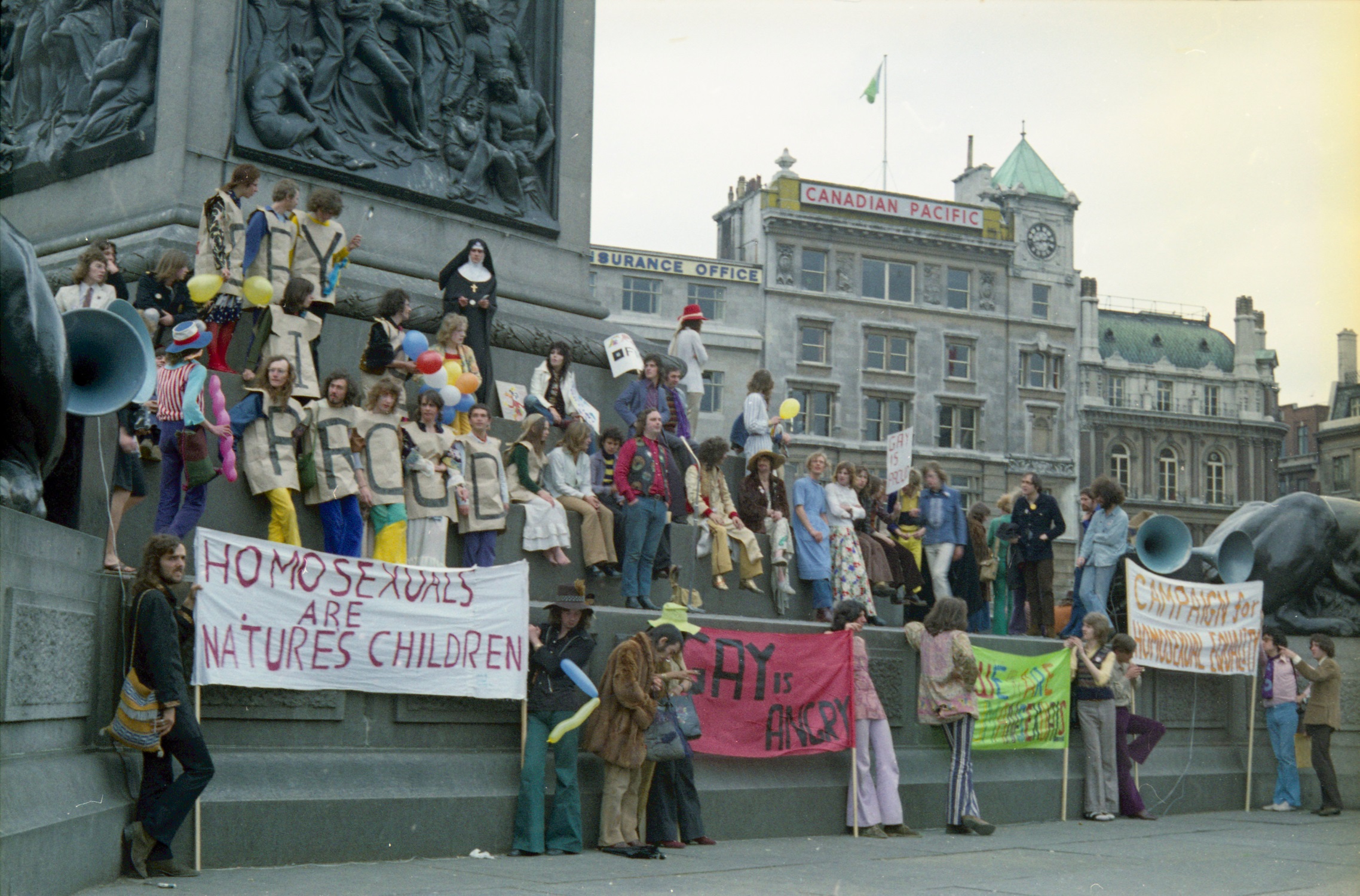
A decade later, the gay community was rocked to its foundations by the Aids crisis. Most of the gains made since Stonewall were lost, and once again we were demonised as corrupters of the innocent. Triggered by tabloid hysteria about the “gay plague”, Section 28 of the Local Government Act 1988 was a knee-jerk reaction to prevent us passing on our wickedness to the next generation. But our heroes wouldn’t give up the fight. 1984 was a particularly inspiring year. Chris Smith became the first MP to come out. An attempt to prosecute London’s pioneering LGBT bookshop Gay’s the Word failed. Lesbians and Gays Support the Miners started doing just that.
PROGRESS
In 1989, actors Ian McKellen and Michael Cashman helped found Stonewall, primarily to fight the inequity of Section 28. It’s now one of the most influential LGBTQ+ organisations in Europe, and is currently supporting the long-delayed ban on so-called ‘conversion therapy’. Stonewall was followed in 1990 by Peter Tatchell’s protest group OutRage! It caused mostly well-justified turmoil for the next 21 years.
The first 20 years of the 21st century could fairly be said to be the first time since Celtic Britain that it has been great to be gay. A succession of new laws has achieved an equality with the straight majority that was literally unthinkable in the 70s. Same-sex marriage wasn’t even included as one of the demands of the Gay Liberation Front Manifesto, published in 1971.
Progress began in 2000 when gay people were allowed to enlist in the military for the first time. In 2001, after a long battle, the age of consent was equalised at 16. The next step was radical: in 2002, (2007 in Scotland) the UK became one of only 12 countries in the world to permit same-sex couples to adopt children. In 2005, civil partnerships paved the way for gay marriage.
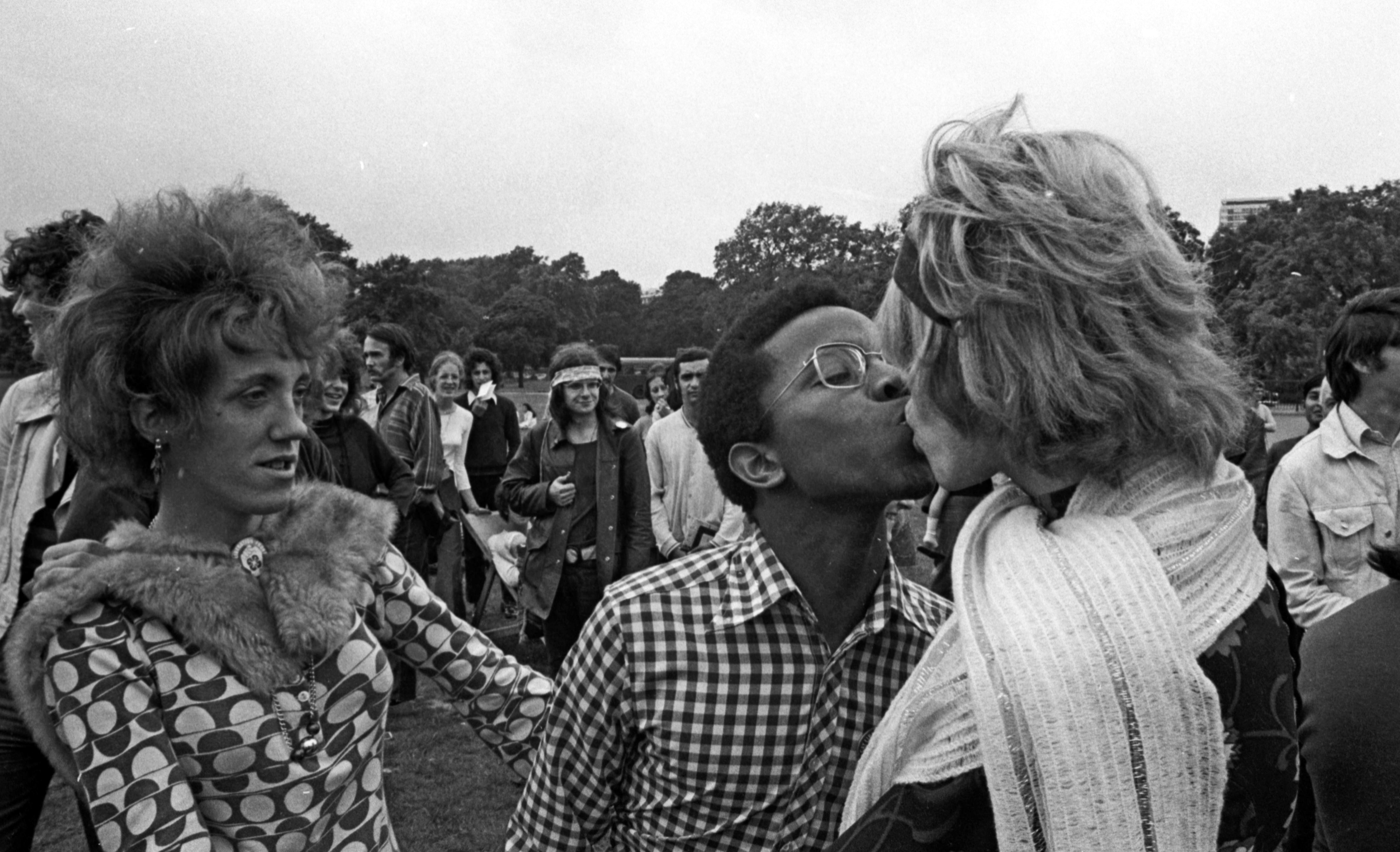
Gay Liberation Front activist Ted Brown (centre) and the Hyde Park kiss-in protest, 1971: “It was far from a bit of fun. We could have been arrested because we were under the age of consent, which at the time was 21.”
Also momentous was the repealing of the 1885 law by the Sexual Offences Act 2003. As Peter Tatchell wrote in The Guardian in 2017, “For the first time in 470 years, England and Wales had a criminal code that did not penalise gay sexuality. In Northern Ireland, the ban on anal sex was not finally repealed until 2008. Scotland’s anti-gay laws were repealed in 2009 but, in the case of sodomy, did not take effect until 2013.”
Since 2005, people have had the right to change their legal gender. In 2007, the Equality Act basically said that we all have to be treated the same and offered the same services as straight people. We have been allowed to marry since 2014 (2020 in Northern Ireland). And that’s just for starters.
“With the legalisation of same-sex marriage, we had some of the best laws in the world,” says Peter Tatchell. ILGA, the international lesbian, gay, bisexual, trans and intersex organisation, tended to agree, when in 2015 it gave the UK the highest progress score in Europe.
Subsequently, we have dropped down the list due to not dealing adequately with issues relating to the trans community. Oh, get it together, UK — this is not a big deal. We owe allegiance to pioneer John/Eleanor Rykener, who appears to have been proudly living as a trans woman more than 600 years ago.
The Attitude July/August issue is out now.
